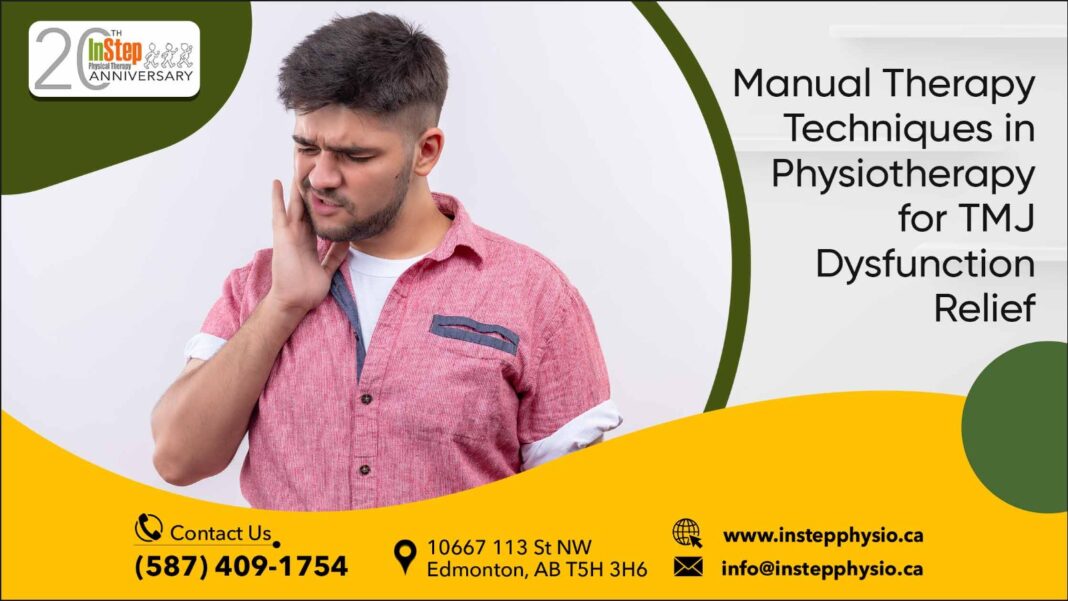Temporomandibular Joint (TMJ) dysfunction can significantly disrupt daily activities, causing pain while talking, chewing, and even yawning. Thankfully, TMJ dysfunction physiotherapy in Edmonton, specifically at In Step Physiotherapy Edmonton, offers manual therapy techniques tailored for TMJ relief. This guest post will delve deep into these techniques and the profound benefits they present to individuals dealing with TMJ discomfort.
Understanding TMJ Dysfunction
The temporomandibular joint works based on the hinge mechanism, linking your jawbone to your skull. This joint’s versatile movement allows us to chew, talk, and open our mouths. Dysfunction can manifest due to myriad reasons, including jaw injury, arthritis, genetics, or grinding teeth. Common symptoms entail pain in the jaw, difficulty chewing, or lockjaw. Understanding the root cause is pivotal for effective therapeutic intervention.
Relationship Between TMJ and Other Body Parts
The temporomandibular joint (TMJ) functions intricately within a network of body structures, emphasizing the body’s interconnected nature. Its interplay with the cervical spine is notably significant. For instance, poor postural habits, like a forward-leaning head due to prolonged screen time, can strain the neck and, by extension, impact the TMJ. Similarly, the posture of the entire body, particularly the alignment of the shoulders and upper back, has indirect implications on TMJ health. The strain or imbalances in these regions can magnify TMJ discomfort.
Moreover, the TMJ’s association doesn’t end with musculoskeletal structures. Surprisingly, its dysfunction can lead to symptoms in the ear, such as ringing, or even result in visual disturbances. Such cross-connections underscore the importance of a holistic approach to TMJ care.
The Value of Manual Therapy for TMJ
Manual therapy, a cornerstone of physiotherapy, uses hands-on techniques aimed at mobilizing joints and soft tissue. For TMJ issues, these techniques are incredibly effective, addressing pain, improving range of motion, and rectifying jaw misalignment. With personalized treatment plans, therapists can specifically target the dysfunction’s root, facilitating a holistic healing process.
Common Manual Therapy Techniques for TMJ Relief
- Soft Tissue Mobilization: This technique, focusing on the muscles and fascia surrounding the TMJ, provides relaxation, reduces muscle tension, and promotes optimal blood flow, thus alleviating pain.
- Joint Mobilization: Here, physiotherapists employ graded pressures in systematic movements to improve the joint’s range, restoring natural function and mobility.
- Myofascial Release: The fascia can sometimes become stiff. By employing gentle stretching and manipulation, therapists can release this tension, offering significant relief.
- Neuromuscular Techniques: Neuromuscular involves retraining the muscles around the jaw to function more harmoniously, decreasing the frequency of grinding or clenching, which can exacerbate TMJ issues.
- Trigger Point Release: Targeting hyperirritable points in the jaw muscles, therapists use sustained pressure to relieve spasms and decrease muscle tightness.
- Craniosacral Therapy: This gentle technique addresses the fluids and protective layers around the brain and spinal cord, indirectly impacting the TMJ.
- Positional Release Techniques: By placing the TMJ and surrounding structures in positions of ease or comfort, pain and tension can be significantly reduced.
The Holistic Approach to Physiotherapy
The journey to healing TMJ dysfunction isn’t just about physical interventions. The physiotherapist intertwines manual therapy with a broader, holistic approach. This includes patient education, therapeutic exercises, and strategies to manage and reduce external stressors, which often aggravate TMJ symptoms.
Patient Education and Home-Based Strategies
Beyond in-clinic treatments, physiotherapists emphasize the role of at-home exercises and lifestyle modifications. They teach patients exercises to strengthen and stretch jaw muscles, proper techniques to massage the TMJ area, and ways to manage pain through heat or cold applications. Understanding triggers, be it certain foods or habits like gum chewing, and making necessary adjustments can have profound effects on symptom alleviation.
Coping Mechanisms: Managing TMJ Flare-Ups
Flare-ups of TMJ dysfunction can be immensely challenging, but with the right strategies, they can be navigated with greater ease.
- Pain Management Techniques: Over-the-counter pain relievers, when taken as prescribed, can be effective. Cold or warm compresses applied to the jawline might also provide relief by reducing inflammation or relaxing the muscles.
- Dietary Adjustments: Opting for softer foods that require minimal chewing can reduce strain on the TMJ during flare-ups. Steer clear of hard or crunchy foods, and cut items into smaller pieces to minimize jaw movement.
- Mindfulness and Relaxation: Stress is a common trigger for TMJ flare-ups. Techniques like deep breathing, progressive muscle relaxation, and meditation can be beneficial. Mindfulness exercises can also enhance awareness of habits like teeth clenching.
- Jaw Exercises: Gentle exercises can help maintain jaw mobility and lessen pain. However, it’s essential to get guidance from a physiotherapist to ensure these exercises are done correctly and are beneficial for the specific TMJ condition.
- Avoiding Extreme Jaw Movements: Limit activities that require wide mouth opening, such as yelling, singing loudly, or biting into large foods like apples.
- Seek Support: Sharing concerns with supportive friends, family, or support groups can be therapeutic. They might offer insights or coping strategies that hadn’t been previously considered.
Embracing Comprehensive Care for TMJ Dysfunction Relief
TMJ dysfunction can be debilitating, but with the right therapeutic intervention, relief is attainable. Manual therapy, especially when combined with patient education and lifestyle adjustments, presents a promising avenue for effective TMJ management. For those in Edmonton, In Step Physiotherapy Edmonton stands as a beacon of expertise and care, ready to guide individuals on their journey to a pain-free life.

